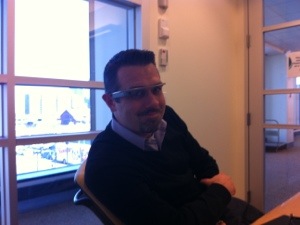My Google Glass Experience
5 Apr, 2013The first 20-30 minutes of horror movies are my favorite. Generally, in the early part of the movie the offending monster hasn’t actually revealed itself yet. It’s all mood, atmosphere, and my imagination filling in the blanks. And, let’s face it, there is no team of Hollywood special effects artists that can match the boogeymen our minds are capable of conjuring. At some point in the second act, the hideous movie monster is revealed, and the fearsome beast I envisioned seems lacking.
Yesterday, I was able to spend some time with Google Glass, and it was very much like coming face-to-face with a very unfrightening cinematic beastie.

Google Glass is not an augmented reality heads up display.
The build-up to Glass has captured the imaginations of many people in the tech space. Security pundits warn that we should fear and shun anyone wearing the contraption. Advocates are gleefully looking forward to a world where this type of wearable computer is the norm. Designers and engineers drool over the possibilities that Glass has to offer from a user interface and development perspective. But nearly all of the hype has been the atmospheric horror movie pre-log; barely any of these people have actually spent any time regarding the monster.
The first thing you should know about Glass: it’s not an augmented reality heads up display (HUD). There is no layer over your vision that provides contextual data about your environment. It’s more along the lines of a tiny head-mounted camera that guys have been using for years to make certain types of adult movies.
There really is no way to discreetly look at the screen while wearing glass. The tiny screen sits in your peripheral vision—just above and to the right of your right eye. Looking at it feels a bit awkward, and unnatural. The content was difficult for me to easily see. I suppose it’s something people could get used to; interacting with touch screen smart phones felt odd for many users when they were initially released, and look at us now.
The primary user input method is voice which, when I was using it, didn’t work nearly as well as natural language recognition works on smartphones. I must have said the start-up command, “OK, Glass” at least a dozen times with no response. Users may swipe a finger along the side of the device—almost like a back button to review Glass activity as a timeline. But even this interaction was inconsistent and lacking.
I do believe in wearable computers, and expect them to become commonplace within the next 5 years. Google Glass may be the first step, but it’s very immature, and has a very long way to go before it becomes something people can’t leave home without.
Posted in Technology | Comments Off on My Google Glass Experience